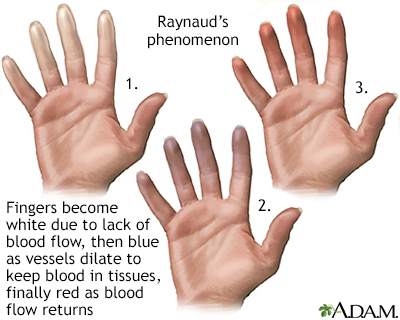Fingers that change color
Definition
Fingers or toes may change color when they are exposed to cold temperatures or stress, or when there is a problem with their blood supply.
Alternative Names
Blanching of the fingers; Fingers - pale; Toes that change color; Toes - pale
Causes
These conditions can cause fingers or toes to change color:
- Buerger disease
- Chilblains (painful inflammation of small blood vessels)
- Cryoglobulinemia
- Frostbite
- Necrotizing vasculitis
- Peripheral artery disease
- Raynaud phenomenon (sudden change in the finger color ranges from pale to red to blue)
- Scleroderma
- Systemic lupus erythematosus
Home Care
Things you can do to help prevent this problem include:
- Avoid smoking.
- Avoid exposure to cold in any form.
- Wear mittens or gloves outdoors and when handling ice or frozen food.
- Avoid getting chilled, which may happen following any active recreational sport or other physical activity.
- Wear comfortable, roomy shoes and wool socks.
- When outside, always wear shoes.
When to Contact a Medical Professional
Call your health care provider if:
- Your fingers change color and the cause is not known.
- Your fingers or toes turn black or the skin breaks.
What to Expect at Your Office Visit
Your provider will perform a physical exam, which will include close examination of your hands, arms, and fingers.
Your provider will ask questions about your medical history and symptoms, including:
- Did the fingers or toes suddenly change color?
- Has the color change occurred before?
- Does the cold or changes in your emotions cause your fingers or toes to turn white or blue?
- Did the skin color changes occur after you had anesthesia?
- Do you smoke?
- Do you have other symptoms such as finger pain? Arm or leg pain? A change in the texture of your skin? Loss of hair on your arms or hands?
Tests that may be done include:
- Antinuclear antibody blood test
- Blood differential
- Complete blood count (CBC)
- Comprehensive metabolic panel
- Duplex Doppler ultrasound of the arteries to the extremities
- Serum cryoglobulins
- Serum protein electrophoresis
- Urinalysis
- X-ray of your hands and feet
Treatment depends on the underlying cause.
Gallery


References
Jaff MR, Bartholomew JR. Other peripheral arterial diseases. In: Goldman L, Schafer AI, eds. Goldman-Cecil Medicine. 26th ed. Philadelphia, PA: Elsevier; 2020:chap 72.
Robert A, Melville I, Baines CP, Belch JJF. Raynaud phenomenon. In: Hochberg MC, Gravallese EM, Silman AJ, Smolen JS, Weinblatt ME, Weisman MH, eds. Rheumatology. 7th ed. Philadelphia, PA: Elsevier; 2019:chap 154.